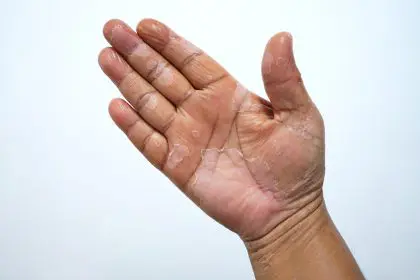Stretch marks — or striae — occur when the skin’s collagen and elastin fibers are torn due to rapid stretching, resulting in the familiar lines that often show up on the abdomen, thighs, hips and breasts. Though medically harmless, their appearance can be bothersome, especially for those who prioritize maintaining smooth, unmarked skin.
We’ll explore effective strategies to keep skin resilient and less prone to stretch marks, including dietary tips, hydration, topical treatments and lifestyle changes. Whether you’re going through pregnancy, weight fluctuations or just want to be proactive, these expert-backed approaches can help you protect your skin’s integrity and confidence.
Understanding stretch marks
What causes stretch marks?
Stretch marks are primarily caused by the rapid stretching of the skin, which can occur due to various factors:
- Pregnancy: As the belly expands to accommodate a growing baby, the skin undergoes significant stretching, often leading to stretch marks.
- Growth spurts: Adolescents going through growth spurts may develop stretch marks as their bodies change rapidly.
- Weight gain or loss: Significant changes in body weight can stretch the skin, resulting in stretch marks.
- Genetics: Some people are more prone to stretch marks due to their genetic makeup, which can affect the skin’s elasticity.
- Medical conditions: Certain medical conditions, such as Cushing syndrome, can lead to the development of stretch marks due to increased cortisol levels.
Understanding the causes of stretch marks is the first step in learning how to prevent them.
The science behind stretch marks
When the skin stretches too quickly, the production of collagen (the protein that keeps the skin firm) and elastin (which helps the skin stretch) is disrupted. This leads to the formation of scars under the skin, which we see as stretch marks. Initially, these marks may appear red, purple or dark brown, depending on skin tone, but over time they often fade to a lighter, silvery shade.
Strategies to avoid stretch marks
1. Maintain a healthy diet
A balanced diet rich in vitamins and minerals is crucial for skin health. Key nutrients that support skin elasticity include:
- Vitamin C: Essential for collagen production, which helps keep the skin firm and resilient.
- Vitamin E: A powerful antioxidant that helps protect the skin from damage.
- Zinc: Promotes healthy skin by supporting cell growth and repair.
- Protein: Provides the building blocks for collagen production.
Incorporating foods like citrus fruits, nuts, seeds, lean meats and leafy greens into your diet can help maintain your skin’s elasticity, making it more resistant to stretch marks.
2. Stay hydrated
Hydration plays a vital role in maintaining skin elasticity. When the skin is well-hydrated, it is more pliable and less prone to tearing under pressure. Aim to drink at least eight glasses of water a day to keep your skin hydrated from the inside out.
In addition to drinking water, you can also consume hydrating foods such as cucumbers, watermelon and celery. These foods are high in water content and can help boost your overall hydration levels.
3. Regular moisturization
Applying moisturizer regularly can help keep your skin soft and supple, making it less likely to develop stretch marks. Look for moisturizers that contain ingredients known for their hydrating and skin-repairing properties, such as:
- Cocoa butter: Widely used for its ability to hydrate and nourish the skin.
- Shea butter: Rich in vitamins A and E, shea butter helps to soothe and moisturize the skin.
- Hyaluronic acid: A powerful humectant that attracts moisture to the skin, helping to maintain its elasticity.
- Retinoids: These derivatives of vitamin A can promote collagen production and improve skin texture, though they should be used with caution during pregnancy.
Apply moisturizer at least twice a day, focusing on areas prone to stretch marks, such as the abdomen, thighs and hips.
4. Exercise regularly
Regular exercise can help maintain a stable weight and improve skin elasticity. Activities that promote circulation and muscle tone — such as swimming, walking and yoga — are particularly beneficial. Exercise not only helps in weight management but also supports healthy skin by improving blood flow, which delivers essential nutrients to the skin.
Strength training can also be effective, as it helps to build muscle and reduce the appearance of stretch marks by firming the skin. However, it’s essential to avoid sudden, extreme changes in body size or shape, as these can contribute to the formation of stretch marks.
5. Gradual weight gain or loss
One of the most effective ways to prevent stretch marks is to avoid rapid weight gain or loss. Sudden changes in body size can put excessive strain on the skin, leading to stretch marks. If you are planning to lose or gain weight, aim for a gradual change to give your skin time to adjust.
During pregnancy, it’s important to follow your health care provider’s guidelines for healthy weight gain. By maintaining a steady rate of growth, you can reduce the likelihood of developing stretch marks.
6. Use topical treatments
Certain topical treatments can help prevent stretch marks or reduce their appearance. These include:
- Creams with hyaluronic acid: This ingredient helps retain moisture in the skin, improving its elasticity.
- Products containing retinoids: As mentioned earlier, retinoids can stimulate collagen production, though they should be avoided during pregnancy unless prescribed by a doctor.
- Silicone gel: Often used to treat scars, silicone gel can also help in the prevention of stretch marks by keeping the skin hydrated and protected.
It’s important to start using these treatments early, especially if you know you are at risk of developing stretch marks due to pregnancy or weight changes.
Emotional impact and acceptance
Understanding the emotional impact
While prevention is ideal, it’s essential to recognize that stretch marks are a common and natural part of life. The pressure to have flawless skin can lead to unnecessary stress and anxiety. It’s important to approach stretch mark prevention with a healthy mindset, understanding that these marks are not a reflection of your worth or beauty.
Embracing your body
Acceptance and self-love are crucial in managing the emotional impact of stretch marks. Many people live with stretch marks, and they are a testament to your body’s ability to grow and change. Embracing these marks as part of your unique journey can help you cultivate a positive body image.
If stretch marks do appear, remember that they often fade over time and can be minimized with various treatments. However, the most important thing is to focus on maintaining a healthy and happy body, rather than striving for perfection.
Preventing stretch marks
Preventing stretch marks requires a combination of healthy lifestyle choices, proper skin care and a positive mindset. By nourishing your skin from the inside out and practicing good habits, you can reduce the likelihood of developing stretch marks. However, it’s equally important to remember that stretch marks are a normal part of life and do not define your beauty.
Whether you’re going through a life stage that makes you more susceptible to stretch marks — like pregnancy or significant weight change — or you simply want to take better care of your skin, the strategies outlined in this article can help you feel confident and empowered in your skin. Embrace your body’s journey and treat it with the care and respect it deserves.
By following these tips and maintaining a positive outlook, you can minimize the appearance of stretch marks and focus on what truly matters — your overall health and well-being.
This story was created using AI technology.

















